Abstract
Tumor necrosis factors alpha and beta (TNF-alpha and TNF-beta) are multifaceted polypeptide cytokines which may mediate some of the significant changes in cellular homeostasis which accompany the invasion of the mammalian host by viruses, bacteria, and parasites. Although it is well established that bacterial lipopolysaccharide is a potent inducer of TNF-alpha, there is still very little known of the types of agents which can trigger the production of TNFs in mononuclear leukocytes. Using an enzyme-linked immunosorbent assay for measuring TNF-alpha and TNF-beta, we examined the capacity of various T-lymphocyte and beta-lymphocyte mitogens as well as microbial components to stimulate production of these cytokines in culture. The mitogens phytohemagglutinin, concanavalin A, and pokeweed mitogen induced production of both TNF-alpha and TNF-beta, while whole-killed Staphylococcus aureus and Bordetella pertussis, like lipopolysaccharide, were potent inducers of TNF-alpha but failed to stimulate TNF-beta production. TNF-alpha production was detectable within 1 h after stimulation, while TNF-beta production was not detected until after 8 h of culture. The bacterial products tetanus toxoid, purified protein derivative, pertussis filamentous hemagglutinin, and pertussis toxin were all able to induce TNF-alpha and TNF-beta production. Disrupted (frozen-thawed) Plasmodium falciparum-infected erythrocytes were also potent inducers of TNF-alpha and TNF-beta. The results demonstrated that a wide variety of microbial components are inducers of TNF-alpha. Some may not only be more effective than lipopolysaccharide but can also induce TNF-beta production. Furthermore, evidence is presented showing that TNF-beta but not TNF-alpha production correlates with lymphoproliferation.
Full text
PDF

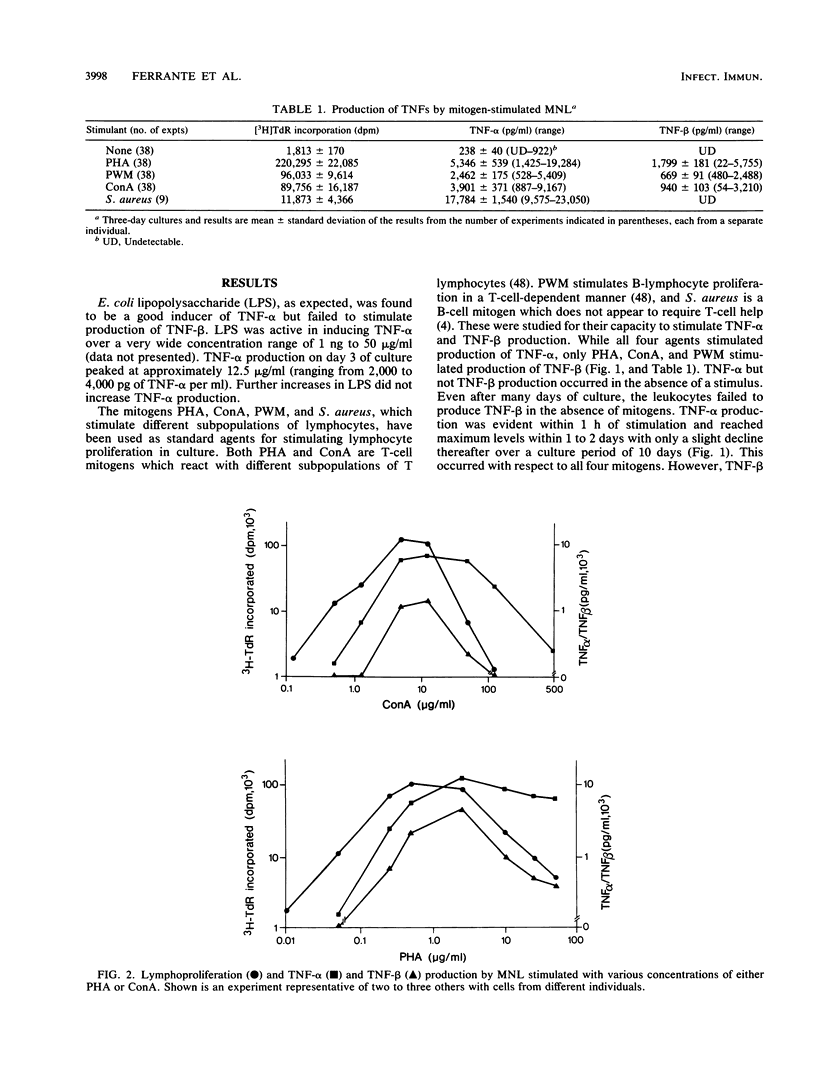
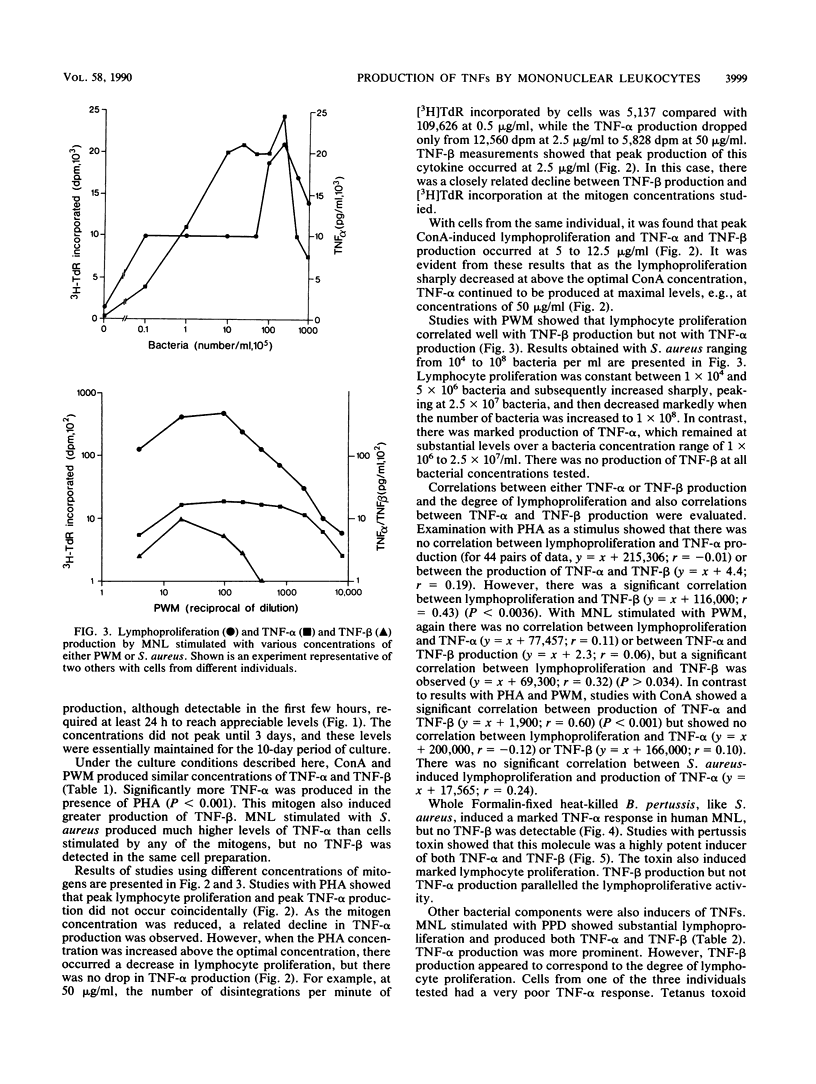

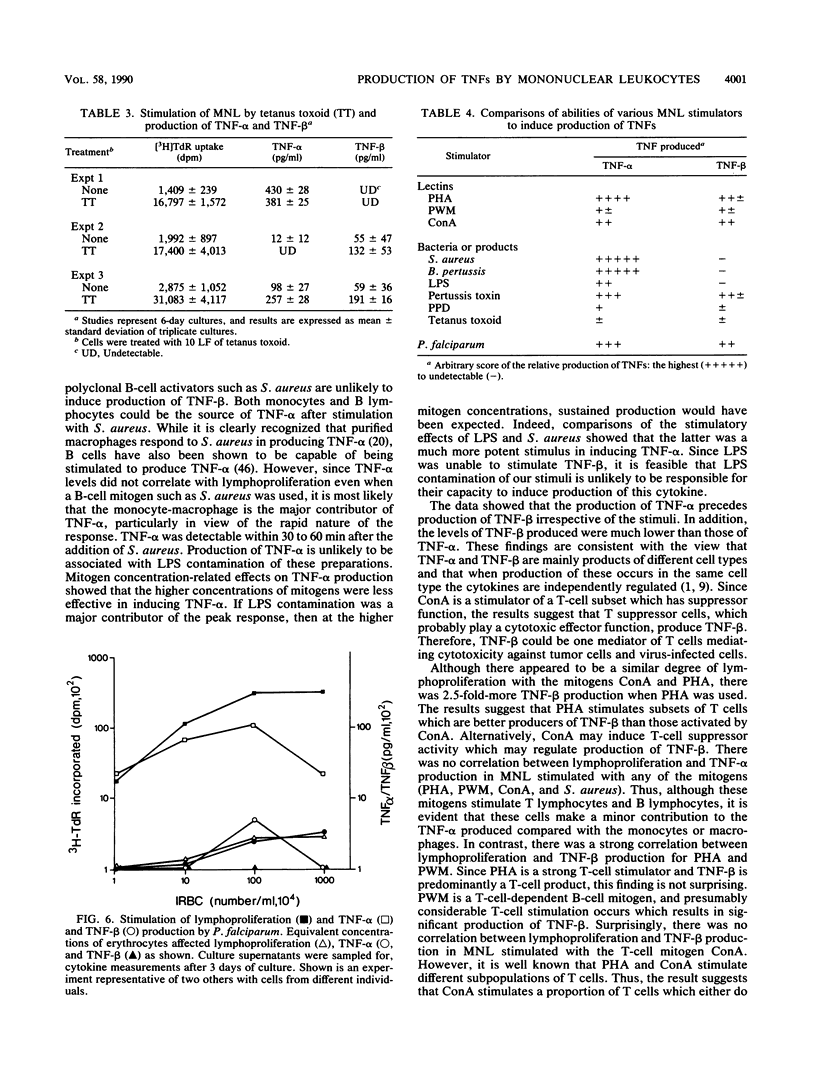
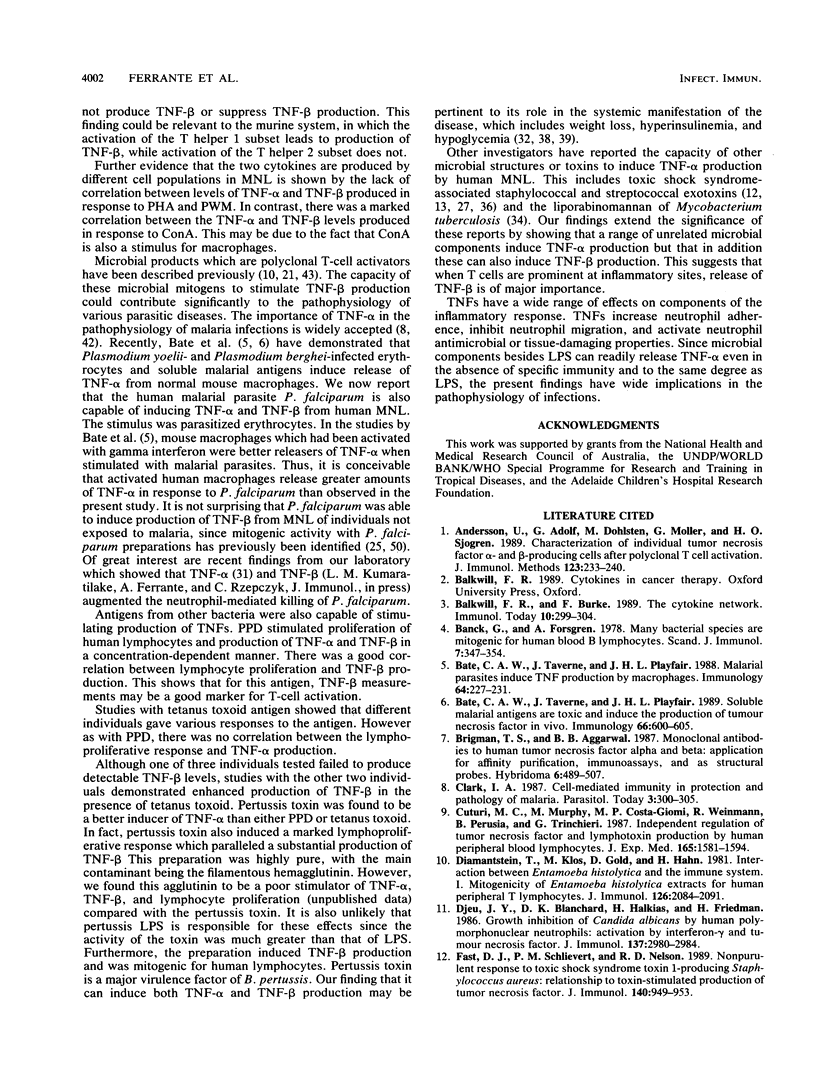
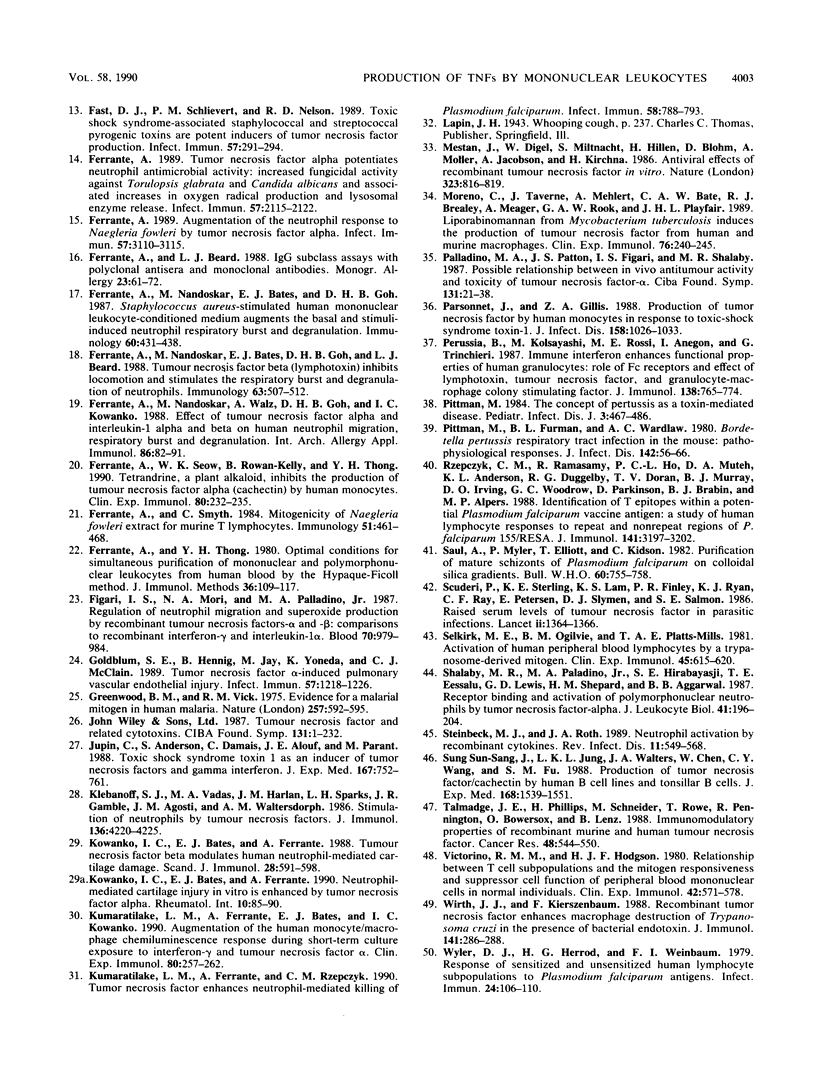
Selected References
These references are in PubMed. This may not be the complete list of references from this article.
- Andersson U., Adolf G., Dohlsten M., Möller G., Sjögren H. O. Characterization of individual tumor necrosis factor alpha-and beta-producing cells after polyclonal T cell activation. J Immunol Methods. 1989 Oct 24;123(2):233–240. doi: 10.1016/0022-1759(89)90227-5. [DOI] [PubMed] [Google Scholar]
- Balkwill F. R., Burke F. The cytokine network. Immunol Today. 1989 Sep;10(9):299–304. doi: 10.1016/0167-5699(89)90085-6. [DOI] [PubMed] [Google Scholar]
- Banck G., Forsgren A. Many bacterial species are mitogenic for human blood B lymphocytes. Scand J Immunol. 1978;8(4):347–354. doi: 10.1111/j.1365-3083.1978.tb00528.x. [DOI] [PubMed] [Google Scholar]
- Bate C. A., Taverne J., Playfair J. H. Malarial parasites induce TNF production by macrophages. Immunology. 1988 Jun;64(2):227–231. [PMC free article] [PubMed] [Google Scholar]
- Bate C. A., Taverne J., Playfair J. H. Soluble malarial antigens are toxic and induce the production of tumour necrosis factor in vivo. Immunology. 1989 Apr;66(4):600–605. [PMC free article] [PubMed] [Google Scholar]
- Bringman T. S., Aggarwal B. B. Monoclonal antibodies to human tumor necrosis factors alpha and beta: application for affinity purification, immunoassays, and as structural probes. Hybridoma. 1987 Oct;6(5):489–507. doi: 10.1089/hyb.1987.6.489. [DOI] [PubMed] [Google Scholar]
- Clark I. A. Cell-mediated immunity in protection and pathology of malaria. Parasitol Today. 1987 Oct;3(10):300–305. doi: 10.1016/0169-4758(87)90187-6. [DOI] [PubMed] [Google Scholar]
- Cuturi M. C., Murphy M., Costa-Giomi M. P., Weinmann R., Perussia B., Trinchieri G. Independent regulation of tumor necrosis factor and lymphotoxin production by human peripheral blood lymphocytes. J Exp Med. 1987 Jun 1;165(6):1581–1594. doi: 10.1084/jem.165.6.1581. [DOI] [PMC free article] [PubMed] [Google Scholar]
- Diamantstein T., Klos M., Gold D., Hahn H. Interaction between Entamoeba histolytica and the immune system. I. Mitogenicity of Entamoeba histolytica extracts for human peripheral T lymphocytes. J Immunol. 1981 Jun;126(6):2084–2086. [PubMed] [Google Scholar]
- Djeu J. Y., Blanchard D. K., Halkias D., Friedman H. Growth inhibition of Candida albicans by human polymorphonuclear neutrophils: activation by interferon-gamma and tumor necrosis factor. J Immunol. 1986 Nov 1;137(9):2980–2984. [PubMed] [Google Scholar]
- Fast D. J., Schlievert P. M., Nelson R. D. Nonpurulent response to toxic shock syndrome toxin 1-producing Staphylococcus aureus. Relationship to toxin-stimulated production of tumor necrosis factor. J Immunol. 1988 Feb 1;140(3):949–953. [PubMed] [Google Scholar]
- Fast D. J., Schlievert P. M., Nelson R. D. Toxic shock syndrome-associated staphylococcal and streptococcal pyrogenic toxins are potent inducers of tumor necrosis factor production. Infect Immun. 1989 Jan;57(1):291–294. doi: 10.1128/iai.57.1.291-294.1989. [DOI] [PMC free article] [PubMed] [Google Scholar]
- Ferrante A. Augmentation of the neutrophil response to Naegleria fowleri by tumor necrosis factor alpha. Infect Immun. 1989 Oct;57(10):3110–3115. doi: 10.1128/iai.57.10.3110-3115.1989. [DOI] [PMC free article] [PubMed] [Google Scholar]
- Ferrante A., Beard L. J. IgG subclass assays with polyclonal antisera and monoclonal antibodies. Monogr Allergy. 1988;23:61–72. [PubMed] [Google Scholar]
- Ferrante A., Nandoskar M., Bates E. J., Goh D. H., Beard L. J. Tumour necrosis factor beta (lymphotoxin) inhibits locomotion and stimulates the respiratory burst and degranulation of neutrophils. Immunology. 1988 Mar;63(3):507–512. [PMC free article] [PubMed] [Google Scholar]
- Ferrante A., Nandoskar M., Bates E. J., Goh D. H. Staphylococcus aureus-stimulated human mononuclear leucocyte-conditioned medium augments the basal and stimuli-induced neutrophil respiratory burst and degranulation. Immunology. 1987 Mar;60(3):431–438. [PMC free article] [PubMed] [Google Scholar]
- Ferrante A., Nandoskar M., Walz A., Goh D. H., Kowanko I. C. Effects of tumour necrosis factor alpha and interleukin-1 alpha and beta on human neutrophil migration, respiratory burst and degranulation. Int Arch Allergy Appl Immunol. 1988;86(1):82–91. doi: 10.1159/000234610. [DOI] [PubMed] [Google Scholar]
- Ferrante A., Seow W. K., Rowan-Kelly B., Thong Y. H. Tetrandrine, a plant alkaloid, inhibits the production of tumour necrosis factor-alpha (cachectin) hy human monocytes. Clin Exp Immunol. 1990 May;80(2):232–235. doi: 10.1111/j.1365-2249.1990.tb05239.x. [DOI] [PMC free article] [PubMed] [Google Scholar]
- Ferrante A., Smyth C. Mitogenicity of Naegleria fowleri extract for murine T lymphocytes. Immunology. 1984 Mar;51(3):461–468. [PMC free article] [PubMed] [Google Scholar]
- Ferrante A., Thong Y. H. Optimal conditions for simultaneous purification of mononuclear and polymorphonuclear leucocytes from human blood by the Hypaque-Ficoll method. J Immunol Methods. 1980;36(2):109–117. doi: 10.1016/0022-1759(80)90036-8. [DOI] [PubMed] [Google Scholar]
- Ferrante A. Tumor necrosis factor alpha potentiates neutrophil antimicrobial activity: increased fungicidal activity against Torulopsis glabrata and Candida albicans and associated increases in oxygen radical production and lysosomal enzyme release. Infect Immun. 1989 Jul;57(7):2115–2122. doi: 10.1128/iai.57.7.2115-2122.1989. [DOI] [PMC free article] [PubMed] [Google Scholar]
- Figari I. S., Mori N. A., Palladino M. A., Jr Regulation of neutrophil migration and superoxide production by recombinant tumor necrosis factors-alpha and -beta: comparison to recombinant interferon-gamma and interleukin-1 alpha. Blood. 1987 Oct;70(4):979–984. [PubMed] [Google Scholar]
- Goldblum S. E., Hennig B., Jay M., Yoneda K., McClain C. J. Tumor necrosis factor alpha-induced pulmonary vascular endothelial injury. Infect Immun. 1989 Apr;57(4):1218–1226. doi: 10.1128/iai.57.4.1218-1226.1989. [DOI] [PMC free article] [PubMed] [Google Scholar]
- Greenwood B. M., Vick R. M. Evidence for a malaria mitogen in human malaria. Nature. 1975 Oct 16;257(5527):592–594. doi: 10.1038/257592a0. [DOI] [PubMed] [Google Scholar]
- Jupin C., Anderson S., Damais C., Alouf J. E., Parant M. Toxic shock syndrome toxin 1 as an inducer of human tumor necrosis factors and gamma interferon. J Exp Med. 1988 Mar 1;167(3):752–761. doi: 10.1084/jem.167.3.752. [DOI] [PMC free article] [PubMed] [Google Scholar]
- Klebanoff S. J., Vadas M. A., Harlan J. M., Sparks L. H., Gamble J. R., Agosti J. M., Waltersdorph A. M. Stimulation of neutrophils by tumor necrosis factor. J Immunol. 1986 Jun 1;136(11):4220–4225. [PubMed] [Google Scholar]
- Kowanko I. C., Bates E. J., Ferrante A. Neutrophil-mediated cartilage injury in vitro is enhanced by tumour necrosis factor alpha. Rheumatol Int. 1990;10(2):85–90. doi: 10.1007/BF02274789. [DOI] [PubMed] [Google Scholar]
- Kowanko I. C., Bates E. J., Ferrante A. Tumour necrosis factor-beta modulates human neutrophil-mediated cartilage damage. Scand J Immunol. 1988 Nov;28(5):591–598. doi: 10.1111/j.1365-3083.1988.tb01491.x. [DOI] [PubMed] [Google Scholar]
- Kumaratilake L. M., Ferrante A., Bates E. J., Kowanko I. C. Augmentation of the human monocyte/macrophage chemiluminescence response during short-term exposure to interferon-gamma and tumour necrosis factor-alpha. Clin Exp Immunol. 1990 May;80(2):257–262. doi: 10.1111/j.1365-2249.1990.tb05244.x. [DOI] [PMC free article] [PubMed] [Google Scholar]
- Kumaratilake L. M., Ferrante A., Rzepczyk C. M. Tumor necrosis factor enhances neutrophil-mediated killing of Plasmodium falciparum. Infect Immun. 1990 Mar;58(3):788–793. doi: 10.1128/iai.58.3.788-793.1990. [DOI] [PMC free article] [PubMed] [Google Scholar]
- Mestan J., Digel W., Mittnacht S., Hillen H., Blohm D., Möller A., Jacobsen H., Kirchner H. Antiviral effects of recombinant tumour necrosis factor in vitro. 1986 Oct 30-Nov 5Nature. 323(6091):816–819. doi: 10.1038/323816a0. [DOI] [PubMed] [Google Scholar]
- Moreno C., Taverne J., Mehlert A., Bate C. A., Brealey R. J., Meager A., Rook G. A., Playfair J. H. Lipoarabinomannan from Mycobacterium tuberculosis induces the production of tumour necrosis factor from human and murine macrophages. Clin Exp Immunol. 1989 May;76(2):240–245. [PMC free article] [PubMed] [Google Scholar]
- Palladino M. A., Jr, Patton J. S., Figari I. S., Shalaby M. R. Possible relationships between in vivo antitumour activity and toxicity of tumour necrosis factor-alpha. Ciba Found Symp. 1987;131:21–38. doi: 10.1002/9780470513521.ch3. [DOI] [PubMed] [Google Scholar]
- Parsonnet J., Gillis Z. A. Production of tumor necrosis factor by human monocytes in response to toxic-shock-syndrome toxin-1. J Infect Dis. 1988 Nov;158(5):1026–1033. doi: 10.1093/infdis/158.5.1026. [DOI] [PubMed] [Google Scholar]
- Perussia B., Kobayashi M., Rossi M. E., Anegon I., Trinchieri G. Immune interferon enhances functional properties of human granulocytes: role of Fc receptors and effect of lymphotoxin, tumor necrosis factor, and granulocyte-macrophage colony-stimulating factor. J Immunol. 1987 Feb 1;138(3):765–774. [PubMed] [Google Scholar]
- Pittman M., Furman B. L., Wardlaw A. C. Bordetella pertussis respiratory tract infection in the mouse: pathophysiological responses. J Infect Dis. 1980 Jul;142(1):56–66. doi: 10.1093/infdis/142.1.56. [DOI] [PubMed] [Google Scholar]
- Pittman M. The concept of pertussis as a toxin-mediated disease. Pediatr Infect Dis. 1984 Sep-Oct;3(5):467–486. doi: 10.1097/00006454-198409000-00019. [DOI] [PubMed] [Google Scholar]
- Rzepczyk C. M., Ramasamy R., Ho P. C., Mutch D. A., Anderson K. L., Duggleby R. G., Doran T. J., Murray B. J., Irving D. O., Woodrow G. C. Identification of T epitopes within a potential Plasmodium falciparum vaccine antigen. A study of human lymphocyte responses to repeat and nonrepeat regions of Pf155/RESA. J Immunol. 1988 Nov 1;141(9):3197–3202. [PubMed] [Google Scholar]
- Saul A., Myler P., Elliott T., Kidson C. Purification of mature schizonts of Plasmodium falciparum on colloidal silica gradients. Bull World Health Organ. 1982;60(5):755–759. [PMC free article] [PubMed] [Google Scholar]
- Scuderi P., Sterling K. E., Lam K. S., Finley P. R., Ryan K. J., Ray C. G., Petersen E., Slymen D. J., Salmon S. E. Raised serum levels of tumour necrosis factor in parasitic infections. Lancet. 1986 Dec 13;2(8520):1364–1365. doi: 10.1016/s0140-6736(86)92007-6. [DOI] [PubMed] [Google Scholar]
- Selkirk M. E., Ogilvie B. M., Platts-Mills T. A. Activation of human peripheral blood lymphocytes by a trypanosome-derived mitogen. Clin Exp Immunol. 1981 Sep;45(3):615–620. [PMC free article] [PubMed] [Google Scholar]
- Shalaby M. R., Palladino M. A., Jr, Hirabayashi S. E., Eessalu T. E., Lewis G. D., Shepard H. M., Aggarwal B. B. Receptor binding and activation of polymorphonuclear neutrophils by tumor necrosis factor-alpha. J Leukoc Biol. 1987 Mar;41(3):196–204. doi: 10.1002/jlb.41.3.196. [DOI] [PubMed] [Google Scholar]
- Steinbeck M. J., Roth J. A. Neutrophil activation by recombinant cytokines. Rev Infect Dis. 1989 Jul-Aug;11(4):549–568. doi: 10.1093/clinids/11.4.549. [DOI] [PubMed] [Google Scholar]
- Sung S. S., Jung L. K., Walters J. A., Chen W., Wang C. Y., Fu S. M. Production of tumor necrosis factor/cachectin by human B cell lines and tonsillar B cells. J Exp Med. 1988 Nov 1;168(5):1539–1551. doi: 10.1084/jem.168.5.1539. [DOI] [PMC free article] [PubMed] [Google Scholar]
- Talmadge J. E., Phillips H., Schneider M., Rowe T., Pennington R., Bowersox O., Lenz B. Immunomodulatory properties of recombinant murine and human tumor necrosis factor. Cancer Res. 1988 Feb 1;48(3):544–550. [PubMed] [Google Scholar]
- Victorino R. M., Hodgson H. J. Relationship between T cell subpopulations and the mitogen responsiveness and suppressor cell function of peripheral blood mononuclear cells in normal individuals. Clin Exp Immunol. 1980 Dec;42(3):571–578. [PMC free article] [PubMed] [Google Scholar]
- Wirth J. J., Kierszenbaum F. Recombinant tumor necrosis factor enhances macrophage destruction of Trypanosoma cruzi in the presence of bacterial endotoxin. J Immunol. 1988 Jul 1;141(1):286–288. [PubMed] [Google Scholar]
- Wyler D. J., Herrod H. G., Weinbaum F. I. Response of sensitized and unsensitized human lymphocyte subpopulations to Plasmodium falciparum antigens. Infect Immun. 1979 Apr;24(1):106–110. doi: 10.1128/iai.24.1.106-110.1979. [DOI] [PMC free article] [PubMed] [Google Scholar]


